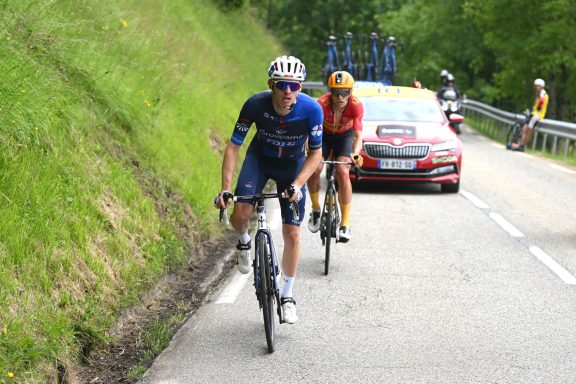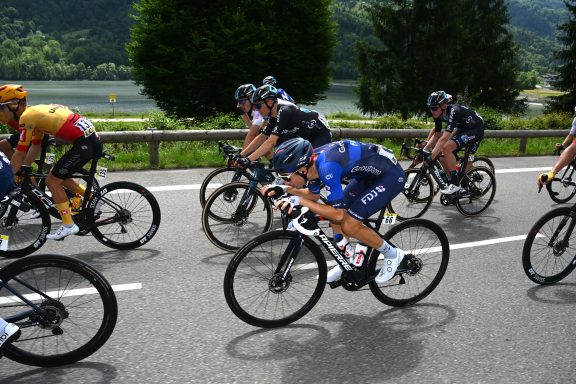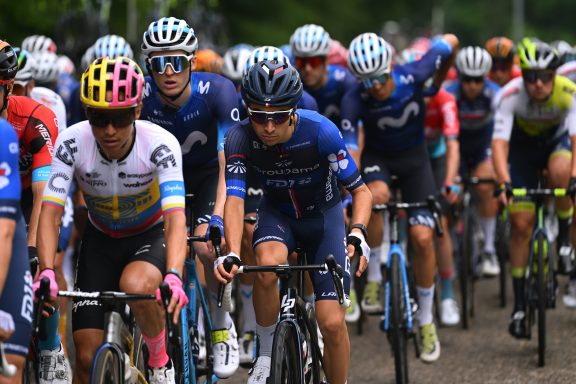The first mountainous stage of the Critérium du Dauphiné, on Friday, was not the hardest one on paper, although the riders still had to tackle the Col de Porte before the hill-top finish in Sappey-en-Chartreuse. Olivier Le Gac spent most of the day in front of the race, while David Gaudu made himself noticed with a fine attack in the last three kilometres. The victory eventually went to Alejandro Valverde in a punchy sprint. Fourteenth on the line, in the same time as the winner, David Gaudu climbs to sixteenth overall.
“I enjoyed trying to attack”, David Gaudu
As an appetizer before the weekend’s main course, the riders of the Critérium du Dauphiné headed for the Chartreuse Mountains on stage 6. Before the climbs however, the first half of the course was almost completely flat on Friday. Due to a hard fight for the breakaway, the first two hours of racing were covered with an average speed of 50 km/h. Olivier Le Gac managed to find his way to the front after forty kilometers and got there with twelve other riders, including the race’s best climber Matthew Holmes (Lotto-Soudal), but also Greg van Avermaet (AG2R-Citroën), the best ranked in the overall. Due to the Belgian’s threat to the yellow jersey, the breakaway was never able to really develop and was always kept within three minutes from the bunch. After the Col de la Placette, the peloton even got closer and headed for the day’s biggest climb, the Col de Porte (7.7km at 6.5%). Before reaching the first slopes of the climb, many riders were dropped in the foothills. Olivier Le Gac lost contact with the leading group after a few minutes of climbing and was finally caught shortly before the summit by a very small peloton.
Brought to the front at the bottom of the Col de Porte, by Matthieu Ladagnous and Kevin Geniets in particular, David Gaudu was able to make his way up the climb in the first positions. “It was another tough day of cycling,” said the Frenchman at the finish. “Either way, there are no easy days on the Dauphiné. The team worked well all day to drop me in a good position at the bottom of the Col de Porte. We still had Olivier in front but the climb was just one kilometre too long for him”. Due to a strong pace in the last three kilometers of the climb, the peloton came back just thirty seconds behind the only break’s survivor, Lawson Craddock. The riders then descended until the bottom of the final climb, which was actually made of two climbs: Côte de la Frette (3.7km at 5.2%) and montée de Sappey-en-Chartreuse (3km at 6%). The leading man was caught by a bunch of around 30 riders just after the first summit, then David Gaudu launched the attacks amongst the favourites with 2,500 meters to go. “I tried to attack quickly to test the legs, and it looked okay,” he said. “Obviously, it cost me for the sprint, but I enjoyed trying to attack and to see where the condition was. I didn’t feel too bad on this last climb”.
“As soon as he’s got an opportunity, he takes it”, Yvon Madiot
After a few moments in the lead, the Vuelta a Pais Vasco stage winner saw Tao Geoghegan Hart bridging across. The other favourites also closed the gap soon after and it all came down to a small, up hill sprint. Alejandro Valverde took the win while David Gaudu finished 14th in the same time. “What David did today is reassuring,” said Yvon Madiot. “If he attacked, it means he felt really good. He did so on the highest slopes. He didn’t have a lot of opportunities to try in that final, if it wasn’t for this hard portion two kilometers from the line. He did not get a large enough gap, and it was impossible to make it to the end as the final was not hard enough and some leaders still had teammates. Still, it’s good that he tried. He was looking forward to it for a few days, as the previous stages were not suitable to him. Today, there were not enough big slopes for climbers like him, but he’s an aggressive kind of rider. As soon as he’s got an opportunity, he takes it.”
His attacking spirit will potentially serve him in the hard weekend lying ahead, through Cormet de Roseland and La Plagne on Saturday, or Joux-Plane on Sunday. “It’s a classic weekend for the Dauphiné, meaning two very difficult stages,” said Yvon. “Tomorrow, we have a beautiful, mythical climb to La Plagne. We know that it can make real gaps. It may be a little less hard on paper on Sunday, but we very often see the Dauphiné being reversed on the last day”. “I hope that the condition will continue to increase,” whispered David Gaudu to conclude.



No comment